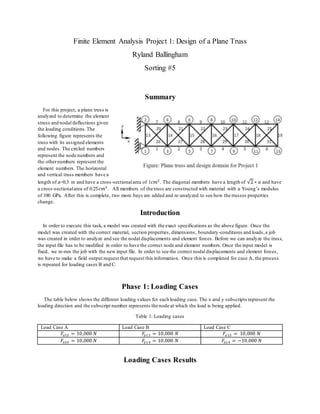This project involves analyzing a plane truss structure using finite element analysis to determine stresses and displacements under different loading conditions. The truss is modeled and analyzed for three loading cases. Equivalent beam properties are then determined for the truss. Finally, the analysis is repeated after extending the truss by two additional bays to observe how the properties change with the increased size.












![References
[1] EML 4507 Project 1.pdf
[2] Beer, Ferdinand P., and E. Russell Johnston. Mechanics of Materials.New York: McGraw-Hill, 1981. Print.](https://image.slidesharecdn.com/1e92d6bf-a91c-4c6c-ae60-d547e9e6fcb9-161224041657/85/FEA_project1-13-320.jpg)